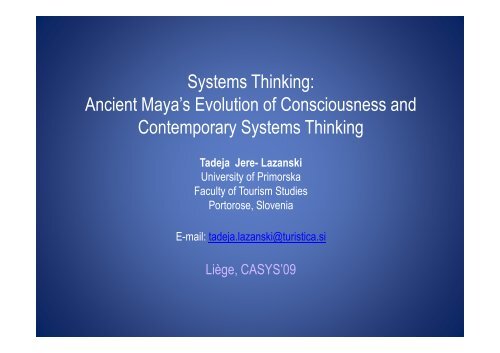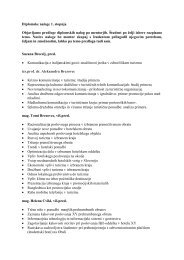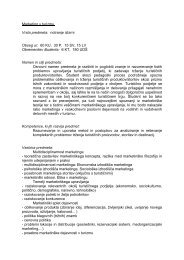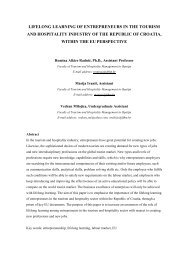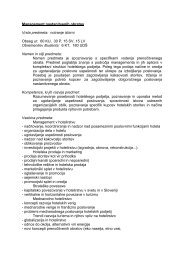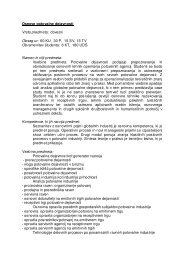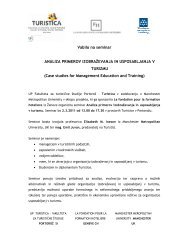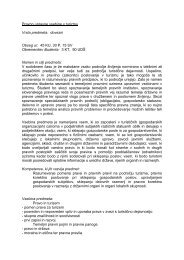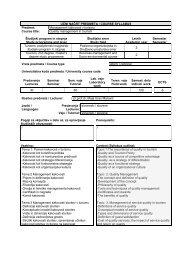Systems Thinking: Ancient Maya's Evolution of ... - Turistica
Systems Thinking: Ancient Maya's Evolution of ... - Turistica
Systems Thinking: Ancient Maya's Evolution of ... - Turistica
You also want an ePaper? Increase the reach of your titles
YUMPU automatically turns print PDFs into web optimized ePapers that Google loves.
<strong>Systems</strong> <strong>Thinking</strong>:<br />
<strong>Ancient</strong> Maya’s <strong>Evolution</strong> <strong>of</strong> Consciousness and<br />
Contemporary <strong>Systems</strong> <strong>Thinking</strong><br />
Tadeja Jere- Lazanski<br />
University <strong>of</strong> Primorska<br />
Faculty <strong>of</strong> Tourism Studies<br />
Portorose, Slovenia<br />
E-mail: tadeja.lazanski@turistica.si<br />
Liège, CASYS’09
Mayan calendars were timing the development and evolution <strong>of</strong><br />
consciousness (individual, societal, universal) The nine-story Mayan<br />
pyramids are thus telling us that consciousness is created in a<br />
hierarchical way and that each Underworld stands on the foundation<br />
<strong>of</strong> another. (Carl Johan Calleman )
Outline<br />
• Overview <strong>of</strong> the <strong>Systems</strong> and <strong>Systems</strong> <strong>Thinking</strong> Through Time<br />
• Gap in History <strong>of</strong> <strong>Systems</strong> <strong>Thinking</strong><br />
• Consciousness<br />
• Coba Stone - a Structure <strong>of</strong> Mayan Calendar – the Mayan System <strong>of</strong><br />
<strong>Evolution</strong> <strong>of</strong> Consciousness<br />
• Pyramid - The Model – Cycles <strong>of</strong> Creation<br />
• Pyramid – The Model the <strong>Evolution</strong>ary System-Conscious <strong>Evolution</strong><br />
<strong>of</strong> Each Cycle<br />
• Principles <strong>of</strong> <strong>Systems</strong> <strong>Thinking</strong> in Mayan and Contemporary Times<br />
• Conclusions
Overview <strong>of</strong> <strong>Systems</strong> and <strong>Systems</strong> <strong>Thinking</strong><br />
Through Time<br />
• Phoenician cuneiform<br />
• Egyptian pyramids<br />
• I Ching<br />
• Pre-Socrates philosophy<br />
and in Heraclites<br />
• Mayan society<br />
• ?<br />
• ?<br />
• ?<br />
• 19th century: Spencer,<br />
Pareto, Durkheim<br />
• 20th century: Bateson,<br />
Mead, Bertalanffy, Wiener,<br />
Picture source: www.ancientx.com
Gap in History <strong>of</strong> <strong>Systems</strong> <strong>Thinking</strong><br />
Analysis has been the dominant mode <strong>of</strong> thought<br />
in the Western world for 400 years. (Ack<strong>of</strong>f)<br />
• Q: How come that synthesis and systems thinking were not the mode<br />
in Western world between 17th – 20th Century ????
Consciousness is the evolutionary system<br />
• What we pay attention to we become conscious <strong>of</strong>.<br />
• Consciousness is the awareness <strong>of</strong> being aware. (Lungold, 2004)<br />
• Mayan Calendar is about evolution <strong>of</strong> consciousness. (Calleman, 2004)<br />
Source: http://wakingdownintegral.com/?p=10
Coba Stone - a Structure <strong>of</strong> Mayan Calendar – the<br />
Mayan System <strong>of</strong> <strong>Evolution</strong> <strong>of</strong> Consciousness<br />
Coba, Mexico: The Mayan Calendar Stone lying<br />
under cover next to second ball court, just past<br />
Casa de Pinturas (ww.mayannmajix.com )<br />
Picture source: Calleman, Solving the Greatest Mystery <strong>of</strong> our<br />
Time: The Mayan Calendar , 2001, Garev Publishing
The Pyramid <strong>of</strong> Cycles <strong>of</strong> Creation<br />
28 th Oct 2011<br />
16.4 billion years ago<br />
1 st<br />
day<br />
820 million years ago<br />
1 st<br />
night<br />
41 million years ago<br />
2 nd<br />
day<br />
2 million years ago<br />
2 nd<br />
night<br />
102,000 years ago<br />
3 rd<br />
day<br />
3115 BC<br />
- Familial<br />
- Mammalian<br />
3 rd<br />
night<br />
1755 AD<br />
- Tribal<br />
4 th<br />
day<br />
5 th Jan 1999<br />
- National<br />
- Cultural<br />
- Ends with the beginning <strong>of</strong> Cellular<br />
4 th<br />
night<br />
10 th Feb 2011<br />
- Planetary<br />
5 th<br />
day<br />
Picture source : www.mayannmajix.com<br />
- Galactic<br />
5 th<br />
night<br />
- Universal<br />
6 th<br />
day<br />
6 th<br />
night<br />
20<br />
days<br />
360<br />
days<br />
20<br />
yrs<br />
400<br />
yrs<br />
8000<br />
yrs<br />
160<br />
k/yrs<br />
3.2<br />
m/yrs<br />
63<br />
m/yrs<br />
1.26<br />
b/yrs<br />
7 th<br />
day
The evolution <strong>of</strong> consciousness<br />
• There are 9 cycles to the evolution <strong>of</strong> consciousness.<br />
• Each cycle has 13 Aspects <strong>of</strong> Creation: 7 days and 6 nights.<br />
Therefore each cycle goes through all 13 Aspects <strong>of</strong> Creation and<br />
each cycle accelerated through each aspect.<br />
• Each cycle length is 1/20 <strong>of</strong> the previous cycle total length.<br />
• The days represent certain period <strong>of</strong> the calendar and the realisation<br />
<strong>of</strong> understanding.<br />
• The nights represent certain period <strong>of</strong> the calendar and the<br />
application <strong>of</strong> understanding.
The evolution <strong>of</strong> consciousness<br />
• 1 st cycle 16.4 b.y.a. (13 hablatuns) – creation <strong>of</strong> the universe. The cycle<br />
ends with cellular life.<br />
• 2 nd cycle 820 m.y.a. (13 alautuns) – start <strong>of</strong> the multi-cellular life.The<br />
cycle ends with fully developed mammal species (first live births).<br />
• 3 rd cycle 41 m.y.a. (13 kinchiltuns) – start <strong>of</strong> the family consciousness.<br />
The cycle ends with fully developed family unit in species (first upright<br />
apes).<br />
• 4 th cycle 2 m.y.a. (13 kalabtuns) – start <strong>of</strong> tribe consciousness. The<br />
cycle ends with fully developed tribal sets in mammal species (first<br />
homo sapiens).<br />
• 5 th cycle 102,000 y.a. (13 piktuns) – start <strong>of</strong> cultures consciousness.<br />
The cycle ends with fully developed and distinct identities between<br />
large conglomerated tribal groups (and agriculture established).
The evolution <strong>of</strong> consciousness<br />
• 6 th cycle 3115 BC (13 baktuns) – start <strong>of</strong> the first nation state<br />
consciousness (Egypt )The cycle ends in whole world divided<br />
into separate nation states.<br />
• 7 th cycle 1755 AD (13 katuns) – start <strong>of</strong> a planetary<br />
consciousness. Start <strong>of</strong> the industrial revolution The cycle ends<br />
in the global government and international agreements<br />
superseding national status. The 1 st true global communication<br />
method is fully implemented in the World Wide Web (the<br />
Internet!)<br />
• 8 th cycle 5 th Jan 1999 (13 tuns) – start <strong>of</strong> the galaxy awareness<br />
(and yet to end) and we are really discovering what is ‘out there’<br />
in the galaxy.<br />
• 9 th cycle 10 th Feb 2011 (13 uinals (=1 tzolkin)) – start <strong>of</strong> the<br />
universal consciousness and will end with our knowledge we are<br />
one with the universe.
2 nd Cycle (Mammalian)<br />
1 st Cycle (Cellular)<br />
Conscious <strong>Evolution</strong> <strong>of</strong> Each Cycle<br />
4 th Cycle (Tribal)<br />
3 rd Cycle (Familial)<br />
6 th Cycle (National)<br />
5 th Cycle (Cultural)<br />
8 th Cycle (Galactic)<br />
7 th Cycle (Planetary)<br />
9 th Cycle (Universal)<br />
Conscious<br />
Co-creation<br />
Ethics<br />
Power<br />
Law & Punishment<br />
Reasoning<br />
Similarity/Difference<br />
Stimulus/Individual Response<br />
Stimulus/Response<br />
Action/Reaction<br />
Source: Calleman, C.J. (2004). The Mayan Calendar and the Transformation <strong>of</strong> Consciousness: Bear &<br />
Co. Rochester Picture source and followied descriptions: www.mayanmajix.com
The First, the Second and the Third Cycle<br />
• 1 st cycle (16.4 b.y.a.) –cellular consciousness.<br />
• Action/Reaction – heat/cold, day/night, through a ball and it<br />
bounces, equal and opposite reaction.<br />
• 2 nd cycle (820 m.y.a.) –mammalian consciousness.<br />
• Stimulus/Response – scare fish and they turn as a shoal,<br />
boxer strikes and opponent ducks, soccer player scores<br />
goal and fans cheer,<br />
• 3 rd cycle (41 m.y.a.) –family consciousness.<br />
• Stimulus/Individual Response – scare monkeys and they<br />
run in different directions,
The Fourth and the Fifth cycle<br />
• 4 th cycle (2 m.y.a.) –tribal consciousness.<br />
• Similarity/Difference – mind takes over from the body, ability<br />
to make decisions, seeing similarity and giving different<br />
responses, 2 people see a patch <strong>of</strong> grass, 1 sees it as a<br />
lawn the other as a pasture.<br />
• 5 th cycle (102,000 y.a.) –cultural consciousness.<br />
• Reasoning – started by the shamans <strong>of</strong> the tribal groups<br />
when they (the shamans/the learned or wise men) came up<br />
with the reasons as to why things are/were the way they<br />
are. These shamans then since evolved into priests and<br />
religions on the basis <strong>of</strong> cosmology, through the cultural<br />
cycle and formed a single pantheon with the religion <strong>of</strong><br />
Egypt. This is where people develop their own styles for<br />
survival according to their reasons for/<strong>of</strong> life.
The Sixth Cycle<br />
• 6 th cycle (3115 BC) –national consciousness.<br />
• Law & Punishment – concept <strong>of</strong> good and evil developed<br />
(in Hebrew Bible with Adam <strong>of</strong> Eve they have the Law not to<br />
eat the apple, and were duly punished for doing so). This is<br />
the idea <strong>of</strong> retribution. Just in the last aspect (400 years <strong>of</strong><br />
the 7 th day) we have discovered the Laws <strong>of</strong> Nature and<br />
Science (Laws <strong>of</strong> Thermodynamics, etc)
The Seventh cycle – Answering the Gap<br />
7 th cycle (1755 AD) –planetary consciousness.<br />
Power - People become above the rule <strong>of</strong> societal law, machines are<br />
developed to do the work <strong>of</strong> men (industrial revolution) Some people<br />
have lots <strong>of</strong> power, knowledge is power, language is power, the<br />
internet has brought power, we have horseless carriages with engines<br />
that have the power <strong>of</strong> many horses. (As a note there is no good or<br />
bad power as consciousness has no good or evil, it is the individual<br />
viewpoint <strong>of</strong> the application <strong>of</strong> power that makes the use <strong>of</strong> power<br />
good or evil. To the universal consciousness everything is just an<br />
experience – there is no good or bad experience)<br />
A: The evolution <strong>of</strong> human consciousness did not allow the<br />
systems thinking to appear as common thinking before the time.
The Eighth Cycle (5 th Jan 1999) –galactic<br />
consciousness<br />
Ethics<br />
Spontaneous solutions through the application <strong>of</strong> law<br />
and power to the benefit to all and everyone. Abuses <strong>of</strong> power<br />
are getting exposed. The general public are<br />
realising they are the ones with the true power and can do<br />
more than the leaders. Ethics are a refined consciousness.
The Ninth Cycle (10 th Feb 2011) –universal<br />
consciousness<br />
Conscious Co-creation<br />
Only a few people experience conscious co-creation.<br />
CONSCIOUSNESS>THOUGHT>LIGHT>MANIFEST (order <strong>of</strong><br />
priority)
Principles <strong>of</strong> <strong>Systems</strong> <strong>Thinking</strong>: Mayan and Modern<br />
<strong>Systems</strong> <strong>Thinking</strong><br />
MAYAN SYSTEMS THINKING<br />
PRINCIPLES<br />
The “Divine plan”<br />
MODERN SYSTEMS THINKING<br />
PRINCIPLES<br />
The “Big picture”<br />
Long term, short term perspectives<br />
Long term, short term perspectives<br />
Measurable and no measurable data<br />
Measurable and no measurable data<br />
Dynamic, complex and interdependent<br />
Dynamic, Complex and interdependent<br />
We are part <strong>of</strong> a system<br />
We are part <strong>of</strong> a system
Mayan Divine Plan and <strong>Systems</strong> Big Picture<br />
Time<br />
Time<br />
Place<br />
Place<br />
Picture source:www.mayannmajix.com<br />
Personal Intent means knowing what (and where)<br />
you are supposed to be doing with your life and how<br />
you can develop your own consciousness.<br />
Adapted from: www.mayannmajix.com<br />
Consciousness is orientated by time, place, personal<br />
intent for being there and the intuition <strong>of</strong> being tied<br />
up in something much bigger than the self.
Conclusion<br />
• <strong>Systems</strong> thinking was overlooked for Western culture’s analytical and<br />
reductionistic worldview, which resulted in the last 400 years.<br />
• Consciousness is an evolutionary system<br />
• Mayan TUN Calendar is the System <strong>of</strong> <strong>Evolution</strong> <strong>of</strong> Consciousness<br />
• Pyramids are the Models <strong>of</strong> Consciousness and the Cycles <strong>of</strong><br />
Creation<br />
• Mayan <strong>Systems</strong> Principles and Modern <strong>Systems</strong> <strong>Thinking</strong> Principles<br />
• The “Divine Plan” or the “Big Picture” (Holistic Approach)<br />
• The Integration <strong>of</strong> All <strong>Systems</strong>
“What from my perspective seems most valuable with it is that it is<br />
possible to say that there is scientific recognition for this theory about<br />
the Mayan calendar, something that has hardly happened before.”<br />
(Calleman, 2009)


